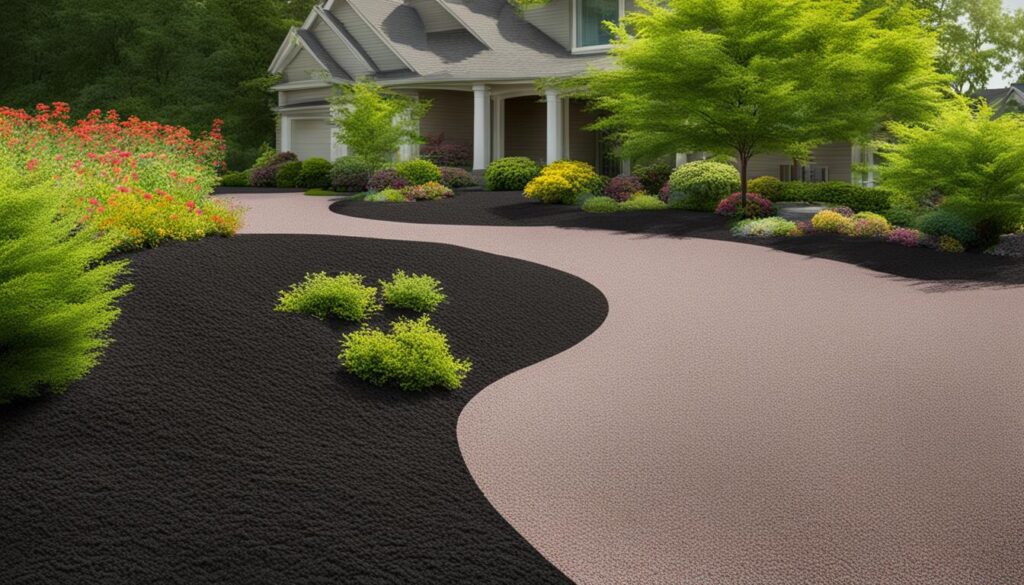Considering rubber mulch for your landscaping needs? Rubber mulch has gained popularity in recent years as a safe and durable landscaping choice. In this article, we will explore the pros and cons of rubber mulch, helping you make an informed decision for your outdoor spaces.
Rubber mulch offers a range of benefits that make it an attractive option for many homeowners. Its low maintenance nature means you can spend less time tending to your landscaping and more time enjoying it. Unlike organic mulch, rubber mulch does not fade or decompose, making it a long-lasting choice.
With its ability to suppress weeds by blocking sunlight and compressing the soil surface, rubber mulch helps keep your landscaping looking neat and tidy. In addition, its cushioning effect makes it an ideal surface for playgrounds, providing a safer area for children to play and reducing the risk of injuries.
However, it’s important to consider the drawbacks of rubber mulch as well. One potential concern is the higher cost compared to organic mulch, as well as the need for additional substrate during installation. Rubber mulch is not biodegradable and does not replenish the soil with nutrients like organic options do.
There is also a possibility of soil contamination due to the leaching of heavy metals such as zinc and chromium from rubber mulch. Additionally, rubber mulch may emit a pungent smell in extreme heat and can be flammable. It is crucial to be aware of these factors when considering rubber mulch for your landscaping needs.
Furthermore, safety concerns and health risks are important considerations. There are ongoing debates about the potential toxicity of rubber mulch to plants, as well as its release of volatile organic compounds (VOCs) that have been linked to health issues. The flammability of rubber mulch poses a fire hazard, and it releases toxic gases when burned. These factors raise questions about the cumulative exposure to toxic chemicals, especially for children.
When it comes to installation and maintenance, rubber mulch requires proper installation techniques and regular maintenance. It is crucial to clear the area, grade for drainage, and use geotextile landscape fabric during installation. Maintenance involves manually removing weeds and debris, as tilling is not recommended. However, it’s worth noting that rubber mulch can become hot in direct sunlight, potentially making it uncomfortable for pets and children.
In conclusion, rubber mulch offers numerous benefits, such as low maintenance, durability, and weed suppression. It is a safe choice for playground surfaces. However, it also has its drawbacks, including higher costs and potential environmental concerns. It’s important to carefully weigh these pros and cons against your specific requirements and concerns to make the best decision for your landscaping needs.
Benefits of Rubber Mulch
When it comes to landscaping and playground safety, rubber mulch offers a range of benefits that make it a popular choice. From low maintenance to long-lasting durability, this material provides several advantages over traditional mulch options.
One of the key advantages of rubber mulch is its low maintenance requirements. Unlike organic mulch, which fades and decomposes over time, rubber mulch retains its color and shape, eliminating the need for frequent replacements. This not only saves you time but also reduces overall maintenance costs.
Another significant benefit is the prolonged lifespan of rubber mulch. It can last up to 10 years, according to most manufacturers, making it a financially sound investment for your landscaping needs. With its exceptional durability, rubber mulch maintains its integrity even in high-traffic areas.
Rubber mulch also excels in weed suppression. By blocking sunlight and compacting the soil surface, it effectively prevents the growth and spread of unwanted weeds. This feature eliminates the constant battle against invasive plants and minimizes the need for additional weed control measures.
Furthermore, rubber mulch provides a safer surface for playgrounds. Its cushioning properties help absorb impact from falls, reducing the risk of injuries. Additionally, the surface is gentle on joints, making it more comfortable for children to play on.
In terms of aesthetics, rubber mulch comes in a variety of colors, allowing you to choose the one that best suits your landscaping preferences. Whether you prefer natural earth tones or vibrant hues, there is a wide selection available to enhance the visual appeal of your outdoor space.
Drawbacks of Rubber Mulch
While rubber mulch has many advantages, it is important to consider its drawbacks before making a decision for your landscaping needs. Here are some of the potential drawbacks of using rubber mulch:
Higher Cost
One of the main drawbacks of rubber mulch is its initial cost. It is typically more expensive than organic mulch, which can be a deterrent for budget-conscious individuals. Additionally, proper installation may require additional substrate, further increasing the overall cost.
Lack of Biodegradability
Unlike organic mulch, rubber mulch is not biodegradable. This means that it does not break down over time and replenish the soil with nutrients like organic mulch does. As a result, you may need to provide additional fertilization and soil amendments to maintain the health of your plants.
Potential Soil Contamination
Another drawback of rubber mulch is the potential for soil contamination. Rubber mulch may leach heavy metals, such as zinc and chromium, into the soil, which can be harmful to plants and the environment. It is important to be mindful of this potential risk and take necessary precautions.
Pungent Smell and Flammability
During extreme heat, rubber mulch may emit a pungent smell, which can be unpleasant for those in close proximity. Additionally, rubber mulch is flammable and can pose a fire hazard. It is important to be cautious when using rubber mulch in areas that are prone to high temperatures or open flames.
Insects, Fungi, and Landscape Fabric
Rubber mulch can provide a favorable environment for insects and fungi to thrive. This can potentially lead to pest infestations and the growth of unwanted fungi. Additionally, rubber mulch may clog landscape fabric, affecting its effectiveness in controlling weeds and water filtration.
Although rubber mulch has its drawbacks, it is essential to weigh these factors against its benefits and your specific requirements before making a decision. The next section will explore the safety concerns and health risks associated with rubber mulch.
Safety Concerns and Health Risks
When it comes to using rubber mulch in your landscaping, there are some important safety concerns and potential health risks that you should be aware of. While rubber mulch offers many benefits, it’s essential to understand the potential drawbacks.
One of the primary concerns is the potential toxicity of rubber mulch to plants. There is a possibility that it may leach chemicals, such as zinc, into the soil. It’s crucial to consider this factor if you have sensitive plants or a vegetable garden.
Another health risk associated with rubber mulch is the release of volatile organic compounds (VOCs). These chemicals have been linked to various health issues, including respiratory problems and skin irritation. It’s especially important to be cautious if you or your family members have respiratory sensitivities.
In addition to health risks, there are also safety concerns regarding the flammability of rubber mulch. It is a fire hazard and can release toxic gases when burned. If you live in an area prone to wildfires or have open flames nearby, this is an important factor to consider.
Athletes who play on synthetic turf fields with rubber mulch infill may also be exposed to harmful chemicals. It’s essential to weigh the potential risks against the benefits when considering the use of rubber mulch in sports facilities and playgrounds.
Lastly, there is ongoing debate regarding the safety of rubber mulch for children. There are concerns about cumulative exposure to toxic chemicals and the potential long-term effects on children’s health. It’s important to stay informed and consider alternative options if you have young children who frequently come into contact with the mulch.
Overall, while rubber mulch offers many advantages, it’s essential to be aware of the safety concerns and potential health risks associated with its use. Consider your specific needs and priorities before making a decision, and always prioritize the health and safety of you and your loved ones.
Installation and Maintenance
Proper installation is essential to ensure the effectiveness and longevity of rubber mulch. Follow these steps for a successful installation:
- Clear the area: Begin by removing any existing vegetation, rocks, or debris from the area where the rubber mulch will be applied.
- Grade for drainage: Ensure proper drainage by grading the area so that water flows away from structures and plants.
- Use landscape fabric: To prevent weed growth, lay down a commercial-grade geotextile landscape fabric before spreading the rubber mulch.
Maintenance requirements for rubber mulch are relatively low compared to other types of mulch. Here are some tips to keep your rubber mulch looking its best:
- Manual weed control: Regularly inspect the rubber mulch and manually remove any weeds or debris that may accumulate. Avoid using a tiller, as it can disturb the landscape fabric.
- Weed suppression: Rubber mulch efficiently blocks sunlight, preventing weed seeds from germinating. This natural weed control method minimizes the need for herbicides.
- Heat resistance: Keep in mind that rubber mulch can absorb heat, making it hot to the touch in direct sunlight. This can be uncomfortable for pets and children, so consider providing shaded areas or alternative play surfaces.
- Clogged landscape fabric: Over time, the landscape fabric under the rubber mulch may become clogged with soil particles, affecting water filtration and insect populations. Regularly inspect and clean the fabric to maintain proper drainage.
Proper installation and maintenance of rubber mulch will ensure its performance and longevity, providing you with an attractive and functional landscaping solution.
Are there any potential weed and feed products that can interact negatively with rubber mulch in landscaping?
Yes, some weed and feed products may interact negatively with rubber mulch in landscaping. Certain chemicals in the products can leach into the surrounding area and cause damage to the rubber mulch. It is important to carefully research and choose weed and feed products that are safe to use with rubber mulch.
Conclusion
After weighing the pros and cons of rubber mulch, it is clear that this landscaping option offers several benefits. With its low maintenance requirements, durability, and effective weed suppression, rubber mulch can be a convenient and long-lasting choice for your outdoor spaces.
However, it is important to consider the drawbacks as well. The higher cost compared to organic mulch, potential soil contamination, and safety concerns are factors that should not be overlooked when making your decision.
When choosing rubber mulch for your landscaping needs, take into account your specific requirements and concerns. Consider your budget, willingness to invest in long-term solutions, and the level of safety you prioritize. Also, think about the potential impact on the environment and aesthetics of your outdoor space.
Ultimately, the decision of whether to use rubber mulch or not should be based on what serves you best, aligns with your priorities, and meets your specific needs. It is important to make an informed decision that will create a safe, visually appealing, and sustainable landscape for years to come.










